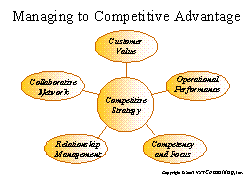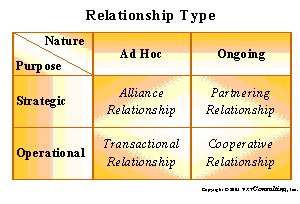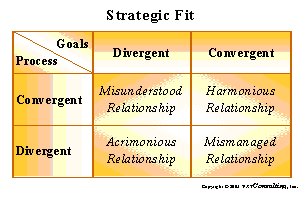At the peak of the Internet bubble there seemed to be no limits to the
market opportunities for the telecom industry. Companies, in the euphoria
of their rising market valuations, would launch into massive M&A
activities. Their objectives: Acquiring market share, building on
capacity, developing capabilities, diversifying product and service
portfolios, synergy, integration and consolidation. Their goal: Toughening
up against the next competitor. But now that the heydays of the
acquisition frenzy are over, we witness the resurgence of strategic
relationships. Could the trend reversal be motivated by necessity (if you
can't buy them, join them), or could it be indicative of management taking
a different tack all together?
Now, while we hear that some business leaders contemplate yet another
mega-merger to broaden their scope and thus plug their revenue drain and
market share loss, we're kindly reminded by Samuel J. Palmisano's
advertising people that in order to achieve a sustainable competitive
advantage one must "think smarter and act faster." Surely, a
good merger can make a lot of sense; but IBM's
commercial epitomizes competitive strategy and points to the fact that
there are many ways to skin a cat. It's all about doing it differently,
doing it first, making it relevant for the customer, and increasing
shareholder value in the process. And that's the different tack that we
have been emphasizing in this current series of articles, as we discuss
the merits of value chain management.
The recurring message remains: Market growth and higher profitability
goals are not chimerical for those competitive firms effectively
addressing in their strategies:

THE SPOTLIGHT ON RELATIONSHIPS
In the first two article of this series, we suggested that competitive
firms focus on customer value creation and gear their operational and
functional performance to optimally achieve the former. In the last
article, "Core Competency And Focus: Strategic And Competitive
Importance," we identified rapid technological changes and the
emergence of new competitors as key contributors to the fragmentation of
the telecommunications industry. In such an environment, competitive firms
choose to specialize and manage the value chain to effectively address
their customers' needs; the customer solution increasingly relying on
intricate amalgamations of components supplied by a variety of vendors
within the value chain, as opposed to the end-to-end services sold by the
old-era vertically integrated operators.
This month, we will shed some light on the significance of effective
strategic relationship management in the current environment. We will
discuss how effective relationship management supports other objectives
thus far discussed in the series, and provide some insight on how to make
them work.
But first, let me share how IBM's latest catchphrase (think smarter/act
faster) resounds with me in the context of value chain management.
Think Smarter
- What provides additional value to my customers that they are not
getting from my competitors?
- How do I provide that value to them at the lowest cost and requiring
the least investment and risk exposure on my part?
- What do I want my customers and the market to believe that I really
am the very best at?
Act Faster
- Are my processes designed to tend to individual customer needs, be
nimble and opportunistic and challenge the competition, without
destroying value?
- Can I retool my assets and have at my disposal the necessary
resources to take advantage of new opportunities and tackle changing
market parameters?
- Will my savoir faire spill into new markets and technological
environments, capitalizing on my leadership to maintain a competitive
edge?
IT'S A VAST WORLD AFTER ALL
Think about all the places, the possibilities and the infinite number of
combinations that exist to accomplish your and your competitors' charters;
it's no wonder that with the rising complexities of solutions and choices
in the marketplace, customers require more of their suppliers to get
satisfied. In the face of increasing competition, that leaves suppliers
with the challenge to have to do more with less. This is the age of
information, in which services and support functions absorb an
increasingly larger portion of the available resources to actually get a
product or service to the customers' premises, and integrated into their
operations. Resources freed from productivity gains and economies of scale
in manufacturing and operations are reallocated to activities necessary to
secure incremental sales. With supply exceeding demand, as is the case in
the telecommunications industry, it is time to think smart, act fast and
establish a sustainable competitive advantage.
No matter how large or how capable it is, a firm can bolster its
competitive position by managing their value chain and collaborating with
other firms. As demand grows more and more diverse, new capabilities and
specialized resources need to be deployed to meet the unique requirement
of the customers' solutions. In conjunction with its goals to maintain
focus and improve performance, the competitive firm establishes and
leverages strategic relationships in order to meet those requirements more
effectively and manage the resources at its disposal most efficiently.
Firms that engage their strategic relationships as a model for doing
business give themselves permission to think smarter. As customers
renounce the substandard solutions resulting from compromise, competitive
firms find in their partners the resources necessary to approach the
market with flexibility and innovation.
- The pooling of knowledge and resources enables them to better track
the pulse of the market and the technological evolution. Their
combined insight allows them to more effectively anticipate their
customers' needs, resolve their solution complexities and cater to the
broader requirements of their customers' value systems.
- To deal with the heterogeneous nature of the demand, competitive
firms develop modular offer platforms which they complete with
offerings from outsourcing, channel, supplier and service partners.
They tap into their partners' specialized resources and expertise to
maximize the value for individual customers at the overall lowest
cost.
- Their relationships allow them to leverage their own unique
resources, qualifications and expertise to branch out into different
market segments; they form partnerships and alliances to extend their
presence into new geographical markets and to go global.
Competitive firms also grant themselves permission to act faster under
the auspices of their strategic relationship networks. They aggressively
seek new opportunities to grow, increase market share and capture
profitability. And while they may relinquish some control over the
customer solution, they mitigate that fact by significantly reducing their
risk exposure. Through the use of existing specialized partner resources
or the sharing of specialized investments, firms offset individual project
risks and concentrate more of their resources on managing their core
activities.
- The competitive firm develops and customizes modular offerings;
delivers them through flexible processes adapted to customer segment
characteristics; and transforms fixed into variable costs to do it
efficiently. Through its strategic relationships, the competitive firm
is thus empowered to engage just the right resources in order to more
adequately customize its solutions, adapt to change, tackle new
segments and take on its competitors on their turf.
- With less invested in specialized resources, the competitive firm is
better positioned to adapt its core assets to the changing market
parameters and/or the product/service specifications. Through
collaboration, it coordinates development of platforms, technologies,
products and services more effectively and gains a time-to-market
advantage.
- With the embedded knowledge and capabilities stemming from its
relationships, the competitive firm puts the focus on its ability to
solve customer problems more effectively and efficiently. Both its
relationships and business practices provide it with the greatest
potential to branch out into other market sectors and build up its
resilience to market changes, competitive threats and disruptive
technologies.
WINNING AT STRATEGIC RELATIONSHIPS
Maximizing tangible and intangible benefits from strategic relationships
is something easier said than done, unfortunately. Often the business news
is marred with reports of ventures or alliances gone wrong; best case
scenario: Investment and time lost; worst case scenario: Customers are
left holding the bag, the business is fleeing, there are high costs of
unwinding the relation, competitive advantages are lost and proprietary
information is compromised. One word of caution for the non-believers
though: This stigma about strategic relationships being temporary and not
working out in the long run has a knack of turning into a self-fulfilling
prophecy. To make strategic relations work you need heart, commitment, a
lot of hard work and most of all -- a diligent approach. While strategic
relationship management is a vast subject, let's highlight some of the
critical aspects.
Determine what you need
Before entering negotiations, you first need to establish your objectives,
identify your alternatives and determine the type of relationship that is
best suited to accomplish your objectives. This provides you with
benchmarks and a framework to determine your course of action.
- Identify the purpose of the relationship and determine whether it is
strategic or operational;
- Assess whether the frequency of your dealings will be ongoing or ad
hoc;
- Establish the importance of joint value creation in the
relationship;
- Decide on the structural autonomy you wish to accomplish for your
operations and value creating abilities;
- Define the scope of the relationship, possibly the duration, and/or
the next evolutionary steps.

Choose your partners carefully
Some marriages are made in heaven; for the rest of us, we have to work on
them on earth. A good start is to establish trust and be candid about your
intentions. Share your respective goals and become familiar with each
other's cultures and processes. No matter what the disparity of size may
be, become comfortable with the mutual commitment to the importance of
success in the relationship. Perform due diligence reviews.
- Ensure that your respective goals are convergent and that their
importance will trump any conflict of interest that could emerge;
- Determine whether your management and operational styles are
compatible and verify that your processes can integrate;
- Set specific goals for the relationship in terms of volume, market
share, performance, etc.;
- Make mutual commitments with respect to specialized investments and
dedicated resources required to succeed;
- Deal with the asymmetry of the relationship and figure out cost,
control, leadership, organization and sharing of the risks and
rewards;
- Verify your partner's capabilities, availability, resources and
organization to ensure that objectives and commitments will be adhered
to, and allow your partner to do the same.

Build the relationship
Like with any relationship, things don't occur all of a sudden just
because you agreed to them, or even less by happenstance. Expectations
must be kept in check and concessions should be made to keep objectives
and results on track. To garner the benefits of your associations, you
must establish an ongoing process through which you'll guide the
relationship, report on its progress and accomplishments, deal with
emerging issues, grow and strengthen it.
- Keep working at the value concept that underscores the relationship.
Increase your competitive advantage by enhancing the effectiveness and
efficiency of your proposition through continued specialization,
innovation and performance improvement.
- Develop the relationship by putting the emphasis on complementing
and cooperating and implement processes that will promote
coordination, synergy and economies of scale. Structure and organize
accordingly.
- Maximize cross-learning and foster effective relationship routines
that contribute to the creation of embedded knowledge. Learning
promotes mutual adaptation and enhances the overall efficiency of the
relationship.
- Manage the relationship to the objectives of all parties involved.
Remain cognizant of your objectives and the market circumstances that
gave rise to the relationship. Understand your role in the
relationship and embrace leadership with fairness and responsibility.
Promote trust and loyalty through equitable distributions of gains
(think Win-Win scenario).
Nurture the relationship
Strategic relationships have a lifecycle of their own. They start, grow,
change and mature along the way, and may eventually outlive their
usefulness. They impact organizations and people on all sides of the
partnership, which leads to a much greater diversity of perspectives on
the markets, goals and objectives from all parties involved. Lest you have
the firm intentions to terminate it, keep the dynamics within the
relationship in check and provide it with the support and resources
necessary to pull through. Don't fail it for the wrong reasons.
- Resist the temptation of falling back into your old routines once
the newness wears off. Competitive dynamics tend to resurface when
organizations and people perceive themselves as independent rather
than interdependent. With the loss of perspective of the total system,
you are in a Zero-Sum-Game.
- Support the relationship by implementing change management and
company-wide PR programs. Enlist facilitators, specifically for your
brainstorm, planning and negotiation sessions, and appoint coaches in
the executive ranks of your respective organizations. Hold them
accountable.
- Help your partners become stronger and better whenever you can.
Their success will add value to your relationship, your customers and
you.
- Prepare for contingencies and implement escalation and conflict
resolution processes. Agree to disagree from time to time, and know
how you are going to handle it.
- Celebrate results, make plans to grow, and spread the word. Keep the
relationship attractive to your best clients, your best partners and
your best employees and you will have a significant competitive
advantage.
When it comes to maximizing customer value and most efficiently
deploying your resources to that effect, strategic relationships provide
significant advantages. While you may have many options at your disposal,
avoid arrogance: Rise to the challenge of strategic relationships by
charting your course carefully and discussing it with your partners openly
and candidly. In this field there are success stories, and then there are
statistics. Manage your strategic relationships to succeed: Stand behind
your commitments, build trust and give it your full support. Unless you do
so, be careful what you wish for�
The subject for our next article will be on collaborative management.
Join us to read about its significance in the context of value chain
management and to learn about how you can prepare for the future dynamics
of your competitive environment.
Xavier Van de Lanotte
is the president of VXTConsulting, Inc. Xavier advises telecommunication
services and equipment firms on Competitive Strategy, Customer Value,
Alliance Management, and Distribution and has worked in this industry in
various parts of the world for 15 years. For more information on value
chain management, please visit us at www.vxtconsulting.com, or contact
us at [email protected].
We welcome your questions and thoughts about this article. |